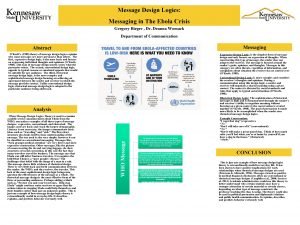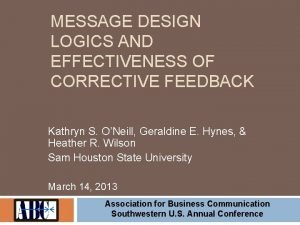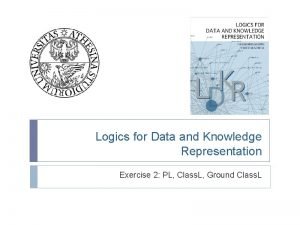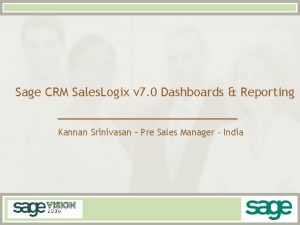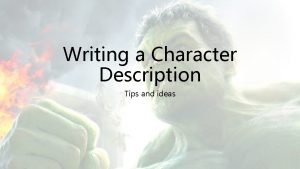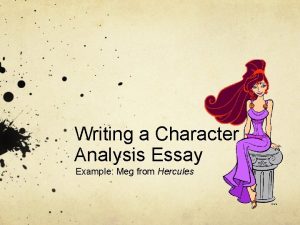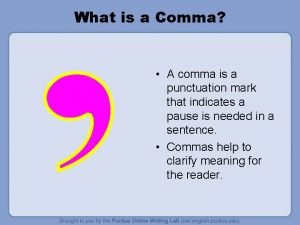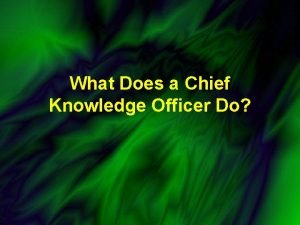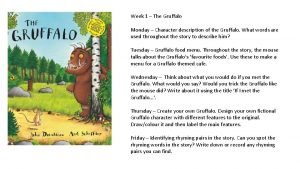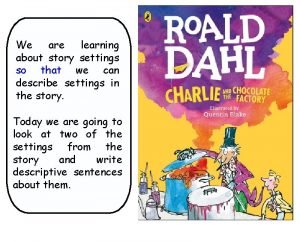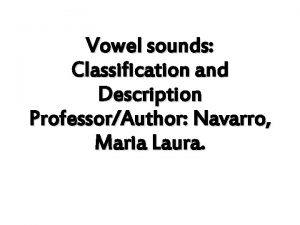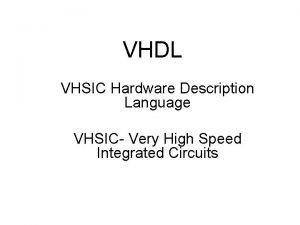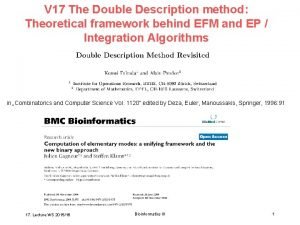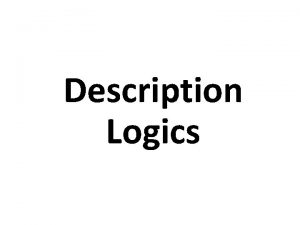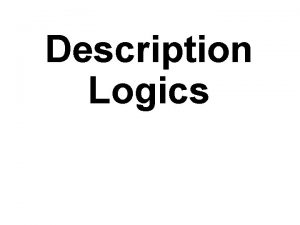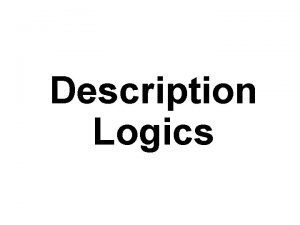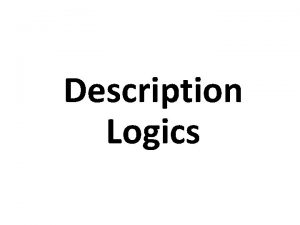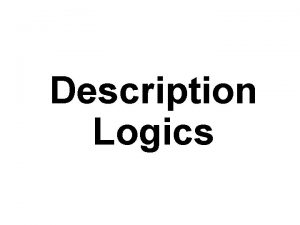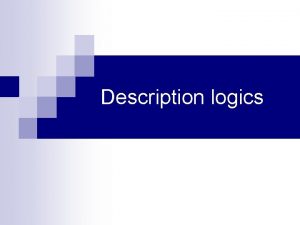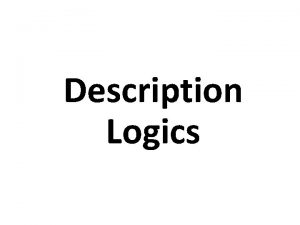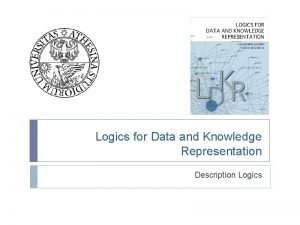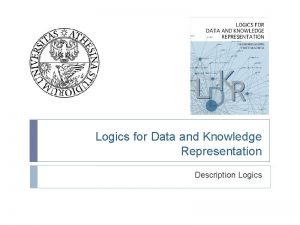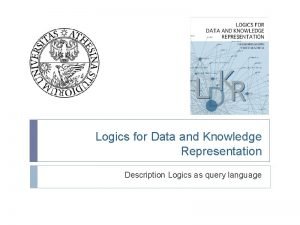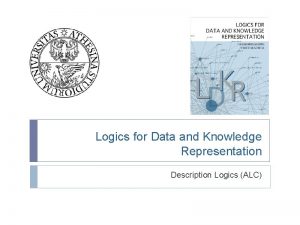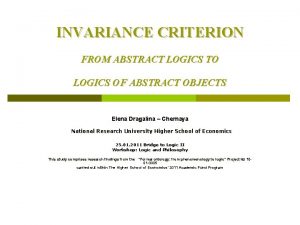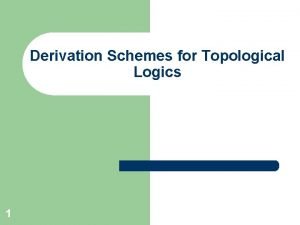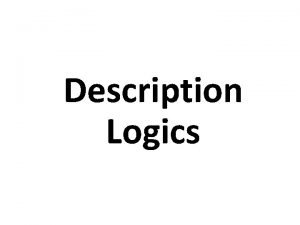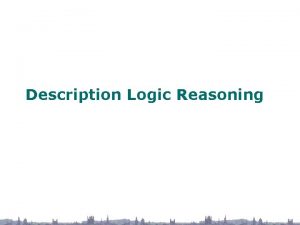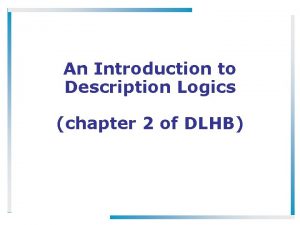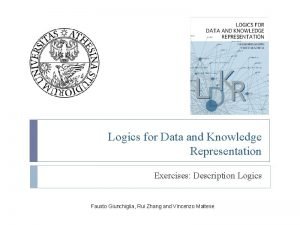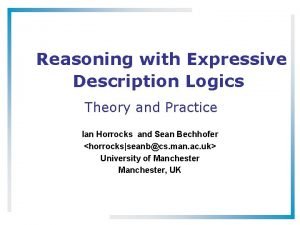An Introduction to Description Logics What Are Description























- Slides: 23

An Introduction to Description Logics

What Are Description Logics? • A family of logic based Knowledge Representation formalisms – Descendants of semantic networks and KL-ONE – Describe domain in terms of concepts (classes), roles (relationships) and individuals • Distinguished by: – Formal semantics (typically model theoretic) • Decidable fragments of FOL • Closely related to Propositional Modal & Dynamic Logics – Provision of inference services • Sound and complete decision procedures for key problems • Implemented systems (highly optimised)

DL Architecture Man ´ Human u Male Happy-Father´ Man u 9 has-child Female u … Abox (data) John : Happy-Father h. John, Maryi : has-child Interface Tbox (schema) Inference System Knowledge Base

Short History of Description Logics Phase 1: – Incomplete systems (Back, Classic, Loom, . . . ) – Based on structural algorithms Phase 2: – Development of tableau algorithms and complexity results – Tableau-based systems for Pspace logics (e. g. , Kris, Crack) – Investigation of optimisation techniques Phase 3: – Tableau algorithms for very expressive DLs – Highly optimised tableau systems for Exp. Time logics (e. g. , Fa. CT, DLP, Racer) – Relationship to modal logic and decidable fragments of FOL

Latest Developments Phase 4: – Mature implementations – Mainstream applications and Tools • Databases – Consistency of conceptual schemata (EER, UML etc. ) – Schema integration – Query subsumption (w. r. t. a conceptual schema) • Ontologies and Semantic Web (and Grid) – Ontology engineering (design, maintenance, integration) – Reasoning with ontology-based markup (meta-data) – Service description and discovery – Commercial implementations • Cerebra system from Network Inference Ltd

Description Logic Family • DLs are a family of logic based KR formalisms • Particular languages mainly characterised by: – Set of constructors for building complex concepts and roles from simpler ones – Set of axioms for asserting facts about concepts, roles and individuals • ALC is the smallest DL that is propositionally closed – Constructors include booleans (and, or, not), and – Restrictions on role successors – E. g. , concept describing “happy fathers” could be written: Man has. Child. Female has. Child. Male has. Child. (Rich Happy)

DL Concept and Role Constructors • Range of other constructors found in DLs, including: – Number restrictions (cardinality constraints) on roles, e. g. , 3 has. Child, 1 has. Mother – Qualified number restrictions, e. g. , 2 has. Child. Female, 1 has. Parent. Male – Nominals (singleton concepts), e. g. , {Italy} – Concrete domains (datatypes), e. g. , has. Age. ( 21), earns spends. < – Inverse roles, e. g. , has. Child- (has. Parent) – Transitive roles, e. g. , has. Child* (descendant) – Role composition, e. g. , has. Parent o has. Brother (uncle)

DL Knowledge Base • DL Knowledge Base (KB) normally separated into 2 parts: – TBox is a set of axioms describing structure of domain (i. e. , a conceptual schema), e. g. : • Happy. Father Man has. Child. Female … • Elephant Animal Large Grey • transitive(ancestor) – ABox is a set of axioms describing a concrete situation (data), e. g. : • John: Happy. Father • <John, Mary>: has. Child • Separation has no logical significance – But may be conceptually and implementationally convenient

OWL as DL: Class Constructors • XMLS datatypes as well as classes in 8 P. C and 9 P. C – E. g. , 9 has. Age. non. Negative. Integer • Arbitrarily complex nesting of constructors – E. g. , Person u 8 has. Child. (Doctor t 9 has. Child. Doctor)

RDFS Syntax E. g. , Person u 8 has. Child. (Doctor t 9 has. Child. Doctor): <owl: Class> <owl: intersection. Of rdf: parse. Type=" collection"> <owl: Class rdf: about="#Person"/> <owl: Restriction> <owl: on. Property rdf: resource="#has. Child"/> <owl: to. Class> <owl: union. Of rdf: parse. Type=" collection"> <owl: Class rdf: about="#Doctor"/> <owl: Restriction> <owl: on. Property rdf: resource="#has. Child"/> <owl: has. Class rdf: resource="#Doctor"/> </owl: Restriction> </owl: union. Of> </owl: to. Class> </owl: Restriction> </owl: intersection. Of> </owl: Class>

OWL as DL: Axioms • Axioms (mostly) reducible to inclusion (v) – C ´ D iff both C v D and D v C • Obvious FOL equivalences – E. g. , C ´ D x. C(x) D(x), C v D x. C(x) D(x)

XML Schema Datatypes in OWL • OWL supports XML Schema primitive datatypes – E. g. , integer, real, string, … • Strict separation between “object” classes and datatypes – Disjoint interpretation domain D for datatypes • For a datavalue d, d. I µ D • And D Å I = ; – Disjoint “object” and datatype properties • For a datatype propterty P, PI µ I £ D • For object property S and datatype property P, SI Å PI = ; • Equivalent to the “(Dn)” in SHOIN(Dn)

Why Separate Classes and Datatypes? • Philosophical reasons: – Datatypes structured by built-in predicates – Not appropriate to form new datatypes using ontology language • Practical reasons: – Ontology language remains simple and compact – Semantic integrity of ontology language not compromised – Implementability not compromised — can use hybrid reasoner • Only need sound and complete decision procedure for: d. I 1 Å … Å d. In, where d is a (possibly negated) datatype

OWL DL Semantics • Mapping OWL to equivalent DL (SHOIN(Dn)): – Facilitates provision of reasoning services (using DL systems) – Provides well defined semantics • DL semantics defined by interpretations: I = ( I, ¢I), where – I is the domain (a non-empty set) – ¢I is an interpretation function that maps: • Concept (class) name A ! subset AI of I • Role (property) name R ! binary relation RI over I • Individual name i ! i. I element of I

DL Semantics • Interpretation function ¢I extends to concept expressions in the obvious way, i. e. :

Interpretation Example = {v, w, x, y, z} AI = {v, w, x} BI = {x, y} RI = {(v, w), (v, x), (y, x), (x, z)} • • • : B= Au. B= : At. B= 9 RB= 8 RB= 9 R (9 R A) = 9 R : (A t B) = 61 RA= >1 RA= AI v w x y z BI

DL Knowledge Bases (Ontologies) • An OWL ontology maps to a DL Knowledge Base K = h. T , Ai – T (Tbox) is a set of axioms of the form: • C v D (concept inclusion) • C ´ D (concept equivalence) • R v S (role inclusion) • R ´ S (role equivalence) • R+ v R (role transitivity) – A (Abox) is a set of axioms of the form • x 2 D (concept instantiation) • hx, yi 2 R (role instantiation) • Two sorts of Tbox axioms often distinguished – “Definitions” • C v D or C ´ D where C is a concept name – General Concept Inclusion axioms (GCIs) • C v D where C in an arbitrary concept

Knowledge Base Semantics • An interpretation I satisfies (models) an axiom A (I ² A): – – – – • • • I ² C v D iff CI µ DI I ² C ´ D iff CI = DI I ² R v S iff RI µ SI I ² R ´ S iff RI = SI I ² R+ v R iff (RI)+ µ RI I ² x 2 D iff x. I 2 DI I ² hx, yi 2 R iff (x. I, y. I) 2 RI I satisfies a Tbox T (I ² T ) iff I satisfies every axiom A in T I satisfies an Abox A (I ² A) iff I satisfies every axiom A in A I satisfies an KB K (I ² K) iff I satisfies both T and A

Multiple Models -v- Single Model • DL KB doesn’t define a single model, it is a set of constraints that define a set of possible models – No constraints (empty KB) means any model is possible – More constraints means fewer models – Too many constraints may mean no possible model (inconsistent KB) • In contrast, DBs (and frame/rule KR systems) make assumptions such that DB/KB defines a single model – Unique name assumption • Different names always interpreted as different individuals – Closed world assumption • Domain consists only of individuals named in the DB/KB – Minimal models • Extensions are as small as possible

Example of Multiple Models KB = {} KB = {a: C, b: D, c: C, d: E, b: C} KB = {a: C, b: D, c: C, d: E, b: C D v C, E v C, d: : C} I 1: = {v, w, x, y, z} CI = {v, w, y} DI = {x, y} EI = {z} a. I = v b I = x c. I = w d I = y I 3: = {v, w, x, y, z} CI = {v, w, y} DI = {x, y} EI = {z} a. I = v b I = y c. I = w d I = z I 2: = {v, w, x, y, z} CI = {v, w, y} DI = {x, y} EI = {z} a. I = v b I = x c. I = w d I = z I 4: = {v, w, x, y, z} CI = {v, w, x, y} DI = {x, y} EI = {z} a. I = v b I = x c. I = y d I = y

Example of Single Model KB = {} I: = {} = {a, b, c, d} CI = {a, c} DI = {b} EI = {d} a. I = a b. I = b c. I = c d. I = d I: = {a, b, c, d} CI = {a, b, c} DI = {b} EI = {d} a. I = a b. I = b c. I = c d. I = d = {a, b, c, d} CI = {a, b, c, d} DI = {b} EI = {d} a. I = a b. I = b c. I = c d. I = d KB = {a: C, b: D, c: C, d: E} KB = {a: C, b: D, c: C, d: E, b: C E v C}

Inference Tasks • Knowledge is correct (captures intuitions) – C subsumes D w. r. t. K iff for every model I of K, CI µ DI • Knowledge is minimally redundant (no unintended synonyms) – C is equivallent to D w. r. t. K iff for every model I of K, CI = DI • Knowledge is meaningful (classes can have instances) – C is satisfiable w. r. t. K iff there exists some model I of K s. t. CI ; • Querying knowledge – x is an instance of C w. r. t. K iff for every model I of K, x. I 2 CI – hx, yi is an instance of R w. r. t. K iff for, every model I of K, (x. I, y. I) 2 RI • Knowledge base consistency – A KB K is consistent iff there exists some model I of K

Single Model -v- Multiple Model Multiple models: • Expressively powerful – Boolean connectives, including : and t • Can capture incomplete information – E. g. , using t and 9 • • – No negation or disjunction • • Monotonic – Adding information preserves truth • Single model: • Expressively weaker (in most respects) Reasoning (e. g. , querying) is hard/slow Queries may give counterintuitive results in some cases Can’t capture incomplete information Nonmonotonic – Adding information does not preserve truth • • Reasoning (e. g. , querying) is easy/fast Queries may give counterintuitive results in some cases
 Mikael ferm
Mikael ferm Message design logics
Message design logics Kr logics
Kr logics Message design logics
Message design logics Sage crm saleslogix
Sage crm saleslogix Q logics
Q logics Sage crm saleslogix
Sage crm saleslogix Intro paragraph outline
Intro paragraph outline Www stands for world wide web
Www stands for world wide web Character description ideas
Character description ideas Example of character analysis
Example of character analysis Whmis 2015 test answers
Whmis 2015 test answers What do you see in this picture
What do you see in this picture Commas to separate adjectives
Commas to separate adjectives Chief knowledge officer responsibilities
Chief knowledge officer responsibilities Thesis description example
Thesis description example Job description vs job specification
Job description vs job specification Gruffalo character traits
Gruffalo character traits Roald dahl setting description
Roald dahl setting description Vowel sound classification
Vowel sound classification Thrips description
Thrips description Vhsic hardware description language
Vhsic hardware description language Double description
Double description Ustad allah bakhsh paintings description
Ustad allah bakhsh paintings description

